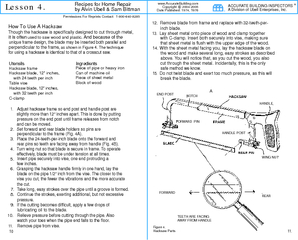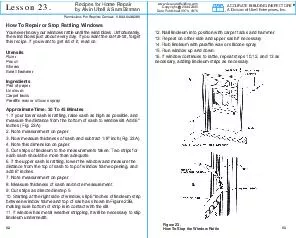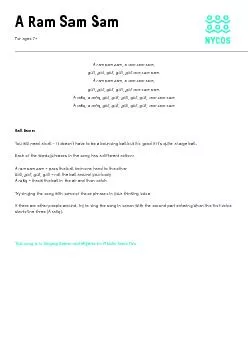PDF-Recipes for Home Repairby Alvin Ubell & Sam Bittman
Author : tatiana-dople | Published Date : 2015-08-03
10 Lesson 4 Permissions For Reprints Contact 18006408285 wwwAccurateBuildingcom ACCURATE BUILDING INSPECTORS A Division of Ubell Enterprises Inc 12 inch from the
Presentation Embed Code
Download Presentation
Download Presentation The PPT/PDF document "Recipes for Home Repairby Alvin Ubell & ..." is the property of its rightful owner. Permission is granted to download and print the materials on this website for personal, non-commercial use only, and to display it on your personal computer provided you do not modify the materials and that you retain all copyright notices contained in the materials. By downloading content from our website, you accept the terms of this agreement.
Recipes for Home Repairby Alvin Ubell & Sam Bittman: Transcript
10 Lesson 4 Permissions For Reprints Contact 18006408285 wwwAccurateBuildingcom ACCURATE BUILDING INSPECTORS A Division of Ubell Enterprises Inc 12 inch from the vise The closer to the H. Monty Python the Flying Circus Are we there yet BartLisa The Simpsons As always thanks for your support Ed Bartles and Jaymes Wine Coolers commercial Autobots transform Optimus Prime The Transformers Aye caramba Bart The Simpsons The balcony is clo Lesson 23. Permissions For Reprints Contact: 1-800-640-8285 www.AccurateBuilding.com ACCURATE BUILDING INSPECTORS A Division of Ubell Enterprises, Inc. 53 Subtract 1/8 fromthis measure 12. Nail lino Paul M. Pietroski. University of Maryland. Dept. of Philosophy, Dept. of Linguistics . James Atlas on Global Warming. (NY Times: Nov 25, 2012) . "a good chance that New York City will sink beneath the sea". Ballads. Learning Target. Analyze characteristics of different forms of poetry - Ballad.. Analyze how meaning is conveyed in poetry through word choice, poetic devices (rhyme, rhythm, repetition, refrain) and figurative language.. : . the Throw-away Society. . . Alvin Toffler. . The Author:. . Alvin Toffler (Oct.3, 1928- ). . An American writer, teacher and futurist, known for his work discussing the digital revolution. ?. . Paul M. Pietroski. University of Maryland. Outline. Gesture at some initial puzzles for truth conditional semantics. Introduce some other puzzles concerning “action reports,” which were supposed to . Paul M. Pietroski. University of Maryland. Outline. Framing effects (e.g., . Kahneman. . and . Tversky. ) . Some puzzles concerning natural language “event variables”. . Two chipmunks chased each other.. Chapter 17. In Deep. Summary. Bob Brown, a design engineer, explains:. the . redesign process . for a deep-water submarine named Alvin.. How . A. lvin will . explore deeper waters . in remote regions to get a glimpse into places that humans . Paul M. Pietroski. University of Maryland. Dept. of Linguistics, Dept. of Philosophy. June 6: General Introduction and “Framing Event Variables”. June 13: “I-Languages, T-Sentences, and Liars”. Evidence. Continue. A small grocery store in your neighborhood was burglarized between 10 pm and 10:15 pm on Friday night. The store closes at 9 pm, and the last person working at the store had left by 10 pm. The burglar stole $500 from a locked cash register, which had been broken open with an axe. A large glass window was broken, and the police believe the burglar entered and left the store through the window. A policeman driving by the store noticed the broken window at 10:15 pm.. Recipes. Recipes can be found in many places, including cookbooks, blogs, magazines, websites, and even food packages. . Recipes. A well-written recipe should have 4 basic parts….. Title. A recipe’s title should be uncomplicated, easy to understand, and accurately describe the recipe.. . SYFTET. Göteborgs universitet ska skapa en modern, lättanvänd och . effektiv webbmiljö med fokus på användarnas förväntningar.. 1. ETT UNIVERSITET – EN GEMENSAM WEBB. Innehåll som är intressant för de prioriterade målgrupperna samlas på ett ställe till exempel:. You will need a ball – it doesn’t have to be a bouncing ball but it’s good if it’s quite a large ball.= roll the ball around your bodyTry singing the song with some of those phrase PurelyHealthyLiving.net is an excellent resource for those who are looking to make positive changes to their lifestyle. With a variety of recipes and information readily available, you can take the first steps towards healthier eating and living.
Download Document
Here is the link to download the presentation.
"Recipes for Home Repairby Alvin Ubell & Sam Bittman"The content belongs to its owner. You may download and print it for personal use, without modification, and keep all copyright notices. By downloading, you agree to these terms.
Related Documents














